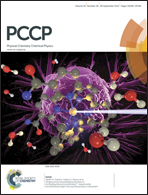A comparative theoretical study of metal functionalized carbon nanocones and carbon nanocone sheets as potential hydrogen storage materials
Abstract
The hydrogen storage of Ti functionalized carbon nanocones and carbon nanocone sheets is investigated by using the state-of-the-art density functional theory calculations. The Ti atom prefers to bind at the hollow site of the hexagonal ring. The average adsorption energies corrected for dispersion forces are −0.54 and −0.39 eV per hydrogen molecule. With no metal clustering, the system gravimetric capacities are expected to be as large as 9.31 and 11.01 wt%. The hydrogen storage reactions are characterized in terms of simulated infrared spectra, projected densities of states, kinetics, and statistical thermodynamics. The free energies and enthalpies of the Ti functionalized carbon nanocone meet the ultimate targets of the Department of Energy for all temperatures and pressures. The closest reactions to zero free energy occur at 378.15 K/2.961 atm for carbon nanocones and 233.15 K/2.961 atm for carbon nanocone sheets. The translational component is found to exert a dominant effect on the total entropy change with temperature. More promising thermodynamics are assigned to the hydrogenation of Ti functionalized carbon nanocone sheets at 233.15 K. As the temperature is increased, the lifetimes of the hydrogen molecules adsorbed at the surface drop and the rate constants increase. At fixed pressure, the rate constants of hydrogenation of Ti functionalized carbon nanocones are smaller than those of Ti functionalized carbon nanocone sheets, while the lifetimes are greater.


 Please wait while we load your content...
Please wait while we load your content...